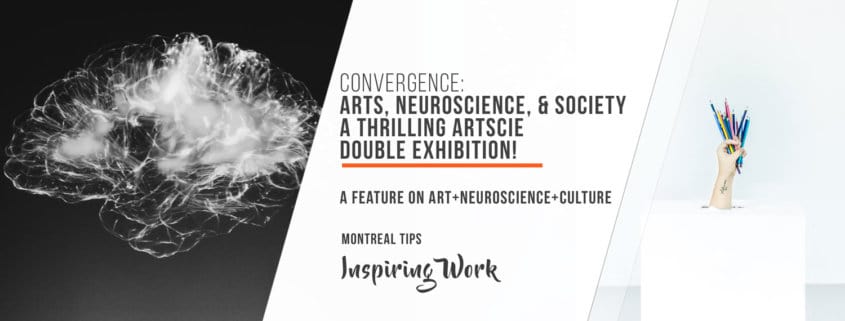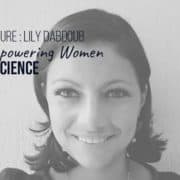Convergence: Arts, Neuroscience, and Society a thrilling Artscie double exhibition!
Convergence: Arts, Neuroscience, and Society a thrilling Artscie double exhibition!
This Friday the first of two inter-intra-trans-disciplinary vernissage happenings will take place at the Visual Voice Gallery at 5 pm. From April 12th to the 27th students form the DART 498: Art+Neuroscience+Culture course taught at Concordia University will be exhibiting their collaborative works in two venues, as mention one is the Visual Voice Gallery at the famous artsy Belgo Building (yes according to Wikipedia this building houses the biggest number of Contemporary Art Galleries in Canada) and the second venue is the Black Box space at Concordia University.
The DART course is in interdisciplinary class that invites students to creatively explore the intersection of arts, neuroscience, and society, and how these domains shape the understandings of ourselves and others. Concordia Fine Arts students work with the RI-MUHC Brain Repair and Integrative Neuroscience program (BRaIN) and McGill Neuroscience students within the Convergence, Perceptions of Neuroscience initiative to create self-directed, collaborative projects which converging artistic and scientific research.
The course combines lectures, debates, site visits, and independent study to encourage all participants to understand and discover territories outside their artistic or scientific comfort zones. The course develops in two terms, where the final work for the artists during the first term consists on creating an artistic response to one of the neuroscience lectures taught. Then, the final projects after the two terms consist on a collaborative project where neuroscience students share their research to inspire the art students. Thus, artists and neuroscientist work hand in hand to produce a piece where convergence actually occurs.
“Our main purpose is to create a connection, a convergence, between different areas of society to make neuroscience research more accessible to the public and to give to our students the opportunity to communicate their research, learn, and acquire a broad perspective from highly skilled artists as well as the public, in the process.”
One of the projects we want to especially acknowledge on this post is Self-flow, a resulting ongoing series of paintings portraying blood vessels with actual blood ink* from the artist Lily Jiménez-Dabdoub.
*Blood was extracted in a safe environment by health professionals— MD. Fernanda and nurse Freddy Jáuregui— who the artists thank. They also encourage those struggling to reach out to professional counselling services.
Self-Flow sensitizes the viewer and connects them with mental health, thus confronting their existing stigmas. Self-Flow is a series of four light boxes containing three layers of organic papers (bamboo, silk and hemp) where images of Liam’s brightfield micrographs of human brain blood vessels (revealed using CD31 immunostaining) were translated by Lily into Sumi-e brush strokes. Then, Liam’s contour drawings were engraved in the glass. The containment of this work represents the contained emotions people suffering from mental health disorders experience due to social stigma. The images are lit to acknowledge these emotions.
Self-Flow unveils a state of peace and creative flow. Human blood* as an ink suits both creators who wanted to portrait its’ emotional intensity and dynamism. The blood degrading colour shows a similarity to the 3,3′-Diaminobenzidine (DAB) staining tint in Liam’s micrograph images and Lily’s own personal experience with depression and anxiety.
Finally, to mention all the works you will find at this thrilling exhibition:
Urban DNA
by Deirdre Hatton (Neuroscience student) and Laura Rosero (Artist). An experimental piece involving volunteer participation and the urban landscape. Urban DNA project aims to investigate the effect of certain genetic mutations on how we navigate through the city.
The Cookie Theft
by Marielle McCrum (Speech Therapist) and Rochelle Panganiban (Artist). Using a common language assessment tool as its base, The Cookie Theft: Case Studies takes invented responses to the test image and depicts them visually. Each script represents different types and severities of communication disorders that could occur following a neurological event such as a stroke.
MS and the Invisible
by Elena Lin (Neuroscience student) and Maria Mathioudakis (Artist). Multiple sclerosis is a debilitating yet often non-communicable disease that attacks the central nervous system. The etiology is not well-understood, and the biological mechanisms that underlie the disorder complex. Of note are immune cells that interact with the nervous system and the profound impact the cells can have in the exacerbation or mitigation of symptoms experienced by patients. The artists were inspired by the contours of moving cells recorded via microscopy: the waves that cells make and their purposeful undulations through space. Using the medium of wire, Mathioudakis and Lin not only capture the idiosyncrasies of cell morphology but also the interplay between what is visible/perceptible (the solidity of the medium) and invisible (the negative space framed and shadows formed). The artwork concomitantly explores concepts of cell-cell interactions in the microscopic world and the macroscopic phenomenology of patient experiences – ultimately bringing into light the pain individuals with multiple sclerosis endure.
Synapsense
by Raina Fan and Erin McKenzie Wall (Neuroscience students), Maya Moussall and Alice Perichon (Artists)
All these works are part of the Visual Voice Gallery exhibition from April 12 – 27, 2019
Vernissage: April 12, 2019, 5 pm – 7 pm
Belgo Building, 372 Ste-Catherine Street West, space 421, Montreal QC, H2V 2K8
The second vernissage will take place on April 27th at The Black Box Space at Concordia University.
Black Box
Exhibition: April 19 – 28, 2019
Vernissage: April 25, 2019, 5 pm – 7 pm
Art & science symposium: April 27, 2019
Concordia University, EV OS3-845/855, 1515 Ste-Catherine West, Montreal QC H3G 2W1
The works you will find here are:
Alien Agency
by Naila Kuhlmann and Zahraa Chorghay (neuroscience students) and the Matthew Halpenny and Matthew Saleciak (Artists).
Sensenet is a conceptual piece realized as an experiential installation, based on the concepts of alien agency in art (a property where the artwork takes on its own meaning, outside the creator’s intent) and the motif of timing and synchrony in neural circuits. By gathering and manipulating data on the senses gathered from participants within the installation environment in real time, Sensenet subverts the individual’s perception and encourages synchronization of the collective senses, thus challenging concepts of identity and consciousness.
🐸 👓 🧠 Frog’s Eye Viewer
by Vanessa Li (Neuroscience student) and Natacha Vieilleux (Artist)
A playful insight into how the developing visual system of a tadpole functions and evolves. In this imaginary tadpole sporting a single giant eye, visual neurons are represented by an army of colourful frogs.
Salience
by Yuting Zhang (Neuroscience student) and Ryan Bruggeman (Artist)
The Network
by Erin McKenzie Wall (Neuroscience student), Giuliana Greto and Tania Marquez (Artists)
Harvesting the Mind Through the Passage of Time
by Morteza Pishnamazi (Neuroscience student) and Tania Marquez (Artist)
Starlight Gone
by Liam O’Leary (Neuroscience student) and Elizabeth Parent
Case and Control
by Kathryn Vaillancourt (Neuroscience student) and Alessandro (Tarek) Ghaleb-Debello (Artist)






 Photo by Verne Ho on Unsplash
Photo by Verne Ho on Unsplash![BOOK-LAUNCH-emailirene_invite[1] Irene book launch banner](https://montrealtips.com/wp-content/uploads/2018/07/BOOK-LAUNCH-emailirene_invite1-180x180.jpg)



